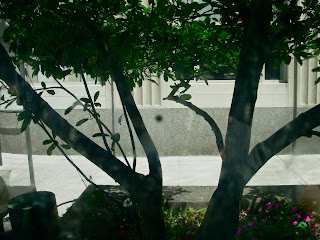
"We have begun to contemplate our origins: starstuff pondering the stars."
--Carl Sagan

And progresses forward to Mercury...
On my first full day in Ithaca Rob and I decided to head downtown and take part in the Carl Sagan Planet Walk. This installation, built in 1997 to honor the famous resident astronomer, is a scale model of the solar system and winds for 3/4 of a mile around the streets of the city and ends (interestingly, still with Pluto as the 9th planet) at the Ithaca Science Center.
It begins with the sun...
Around the main pedestal is etched the quote from Sagan above. Carl Sagan was a professor at Cornell University--Rob's current employer--from 1968 until his death in 1996 and posthumously remains one of the most recognizable advocates for astronomy and scientific philosophy. While walking the halls of Cornell's astronomy building it is exciting to imagine Sagan working and teaching within its walls.

And progresses forward to Mercury...
A planet with long days, long nights, and incredibly large swings in temperature. Mercury rotates on its axis only 3 times for every 2 trips it completes around the sun and its days are over 58 earthdays long. Because it has no protective atmosphere, the side facing the sun heats to 427° celsius, while its dark side plunges to minus 183° celsius.
Venus...
whose incredibly thick atmosphere, dominated by the greenhouse gas carbon dioxide, contributes to its surface reaching temperatures of 450° celsius...hotter than Mercury despite being much further away from the sun than its tiny rocky neighbor.
At each stone station, the glass in the middle continues to represent the size of the sun while a model of the planet sits suspended in its center. If you start the walk with the rocky inner planets, this is a bit confusing at first until you realize that the planet you're looking for within the glass may be no bigger than a spec of dust. Mercury was utterly invisible to my camera, but venus came through as a black dot against a white background and our own planet appeared as a little blue smudge about to be trampled by an unwitting passerby...


Mars, of course, comes next in the line up...

And is followed by a monument to the asteroid belt complete with an actual iron meteorite...
The asteroid belt lies between Mars and Jupiter roughly the spot where another planet "should" reside. It is believed that a planet does not exist there because Jupiter's tremendous gravity may have prevented a large world from forming. Instead we've been left with hundreds of thousands of these oddly shaped space rocks fumbling through the blackness.
 On this marker there is a convenient diagram showing the size of a few asteroids as compared to the local "finger": Cayuga Lake. For me, this proved a potent illustration and as we continued the walk I kept imagining the lake turning end over end in the vastness of space...quite an image!
On this marker there is a convenient diagram showing the size of a few asteroids as compared to the local "finger": Cayuga Lake. For me, this proved a potent illustration and as we continued the walk I kept imagining the lake turning end over end in the vastness of space...quite an image!Science fiction movies all seem to illustrate the asteroid belt as a virtual mine field of small to gigantic rocks. In reality, this area of space is still relatively empty and collisions are rare. Models like the planet walk are excellent ways to try to wrap your brain around the sizes and distances that exist in space, but its vastness still boggles the mind.
Up next is Jupiter...which shows up in the glass much better than the others...

And, then perhaps the most striking of our solar system's planets: Saturn...
And after crossing a bridge featuring a decorative display of all the planet's signs, Neptune...
Everyone knows that these two icy little specs out in the Kuiper Belt are no longer considered true planets...right? I can accept that the original Pluto monument was left here for historical purposes, or perhaps out of deference to Carl, but why not an additional plaque or at least a note updating the status of our former 9th planet to "dwarf planet" and then perhaps adding some of Pluto's neighbors to the line up? I'm sure Dr. Sagan would have been more than happy to acknowledge this new bit of astronomical knowledge...
These are all Kuiper Belt Objects that also happen to cross the orbit of Neptune...a collision between a gas giant and an icy dwarf?...what a thing to imagine!











No comments:
Post a Comment